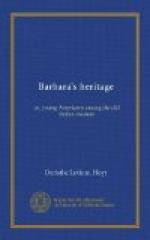Chapter XVI.
Poor Barbara’s Trouble.
O, how this spring of love resembleth The uncertain glory of an April day; Which now shows all the beauty of the sun, And by and by a cloud takes all away.
—SHAKESPEARE.
[Illustration: A BIT OF AMALFI.]
Barbara and Bettina, sometimes accompanied by Mrs. Douglas, sometimes by Malcom, usually by Margery, saw all the remaining and important art treasures of Rome.
They studied long the Vatican and Capitol sculptures; went to the Barberini Palace to see Raphael’s La Fornarina, so rich in color; and, close beside it, the pale, tearful face of Beatrice Cenci, so long attributed to Guido Reni, but whose authorship is now doubtful; to the doleful old church Santa Maria dei Capuccini, to see St. Michael and the Dragon by Guido Reni, in which they were especially interested, because Hawthorne made it a rendezvous of the four friends in his “Marble Faun,” where so diverse judgments of the picture were pronounced, each having its foundation in the heart and experience of the speaker. They had been reading this book in the same way in which they had read “Romola” in Florence, and each girl was now the happy possessor of a much-prized copy, interleaved by herself with photographs of the Roman scenes and works of art mentioned in the book.
They went to the garden-house of the Rospigliosi Palace to see on its ceiling Guido Reni’s Aurora, one of the finest decorative pictures ever painted. And to the Accademia di San Luca to find the drawing by Canevari after Van Dyck’s portrait of the infant son of Charles I. in the Turin Gallery, which is so often reproduced under the name of the Stuart Baby. Not many pictures, great or small, escaped their eager young eyes. They grew familiar with the works of Domenichino, Guercino, Garofalo, Carlo Dolci, Sassoferrato, etc., and the days of their stay in Rome rapidly passed by.
Mrs. Douglas was very desirous to take them for a few days to Naples, or rather to the environments of Naples. To herself it would be a pilgrimage of affection; and in those drives, loveliest in the world, she would recall many precious memories of the past.
“I hesitated to speak of doing this before,” said she, when she suggested it to her brother, “because I have tried to make the whole trip comparatively inexpensive, remembering the shortness of the dear doctor’s purse. Now, of course, this needs no consideration.”
So they planned to go there for a short visit; and on their return it would be time to pack their trunks for Florence, where they were to stop two or three days before going northward toward Venice.
A morning ride from Rome to Naples during the early days of May is idyllic. In the smiling sunshine they rushed on through wide meadows covered with luxuriant verdure and vineyards flushed with delicate greens. After they had passed Capua, which is magnificently situated on a wide plain,—amphitheatre-like within its half-circle of lovely hills, flanked behind by the Apennines,—Malcom said, as he finally drew in his head from the open window and, with a very contented look, settled back into a corner of the compartment, with one arm thrown about his mother’s shoulders:—




